
Salvia officinalis is a perennial, evergreen subshrub, with woody stems, grayish leaves, and blue to purplish flowers. It is a member of the mint family Lamiaceae and native to the Mediterranean region, though it has been naturalized in many places throughout the world. It has a long history of medicinal and culinary use, and in modern times it has been used as an ornamental garden plant. The common name "sage" is also used for a number of related and unrelated species.
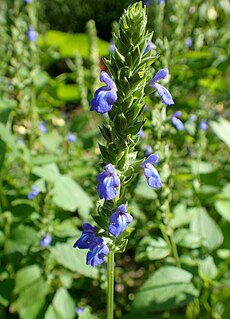
Salvia hispanica, commonly known as chia, is a species of flowering plant in the mint family, Lamiaceae, native to central and southern Mexico and Guatemala. It is considered a pseudocereal, cultivated for its edible, hydrophilic chia seed, grown and commonly used as food in several countries of western South America, western Mexico, and the southwestern United States.

Salvia mellifera is a small, highly aromatic, evergreen shrub of the genus Salvia native to California, and Baja California, Mexico. It is common in the coastal sage scrub of Southern California and northern Baja California. Black sage has a dark appearance, especially during drought.

Salvia apiana, the white sage, bee sage, or sacred sage is an evergreen perennial shrub that is native to the southwestern United States and northwestern Mexico, found mainly in the coastal sage scrub habitat of Southern California and Baja California, on the western edges of the Mojave and Sonoran deserts.
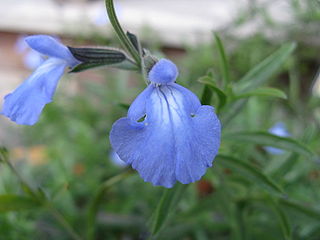
Salvia azurea, the azure blue sage, azure sage, blue sage or prairie sage, is a herbaceous perennial in the genus Salvia that is native to Central and Eastern North America.
Salvia candidissima is a herbaceous perennial native throughout western Greece, and parts of Turkey, Iraq, and Iran, generally between 2000 and 6500 feet elevation. Several small stems grow almost horizontally from the roots before bearing upright inflorescences. The plant reaches 3 ft in height and width in the wild. The light green leaves, 6 in long by 4 in wide, are covered with hairs on both sides and often have notches on the edges. The leaves become lighter in color as the weather gets hotter. The 8–12 inch inflorescences are branched, with 1 inch flowers in whorls that are creamy white and sometimes tipped with a yellow lip. Salvia candidissima is one of a group of seven salvias that are closely related, grow in the same habitat, and easily hybridize with each other, resulting in a great deal of variety in the species.
Salvia disermas is a herbaceous perennial shrub native to South Africa, found in streambeds, moist forest, grassland, and disturbed ground. It was originally specified as rugosa, but was changed to disermas. It grows throughout west Africa, with its greatest concentration in South Africa, where it is used medicinally as a tea, and as a lotion for treating sores.
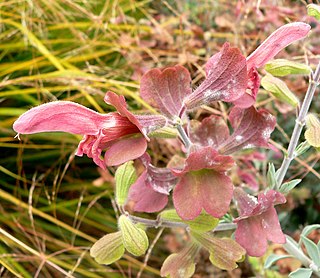
Salvia lanceolata is a perennial shrub native to a small area of coast on the Cape of Good Hope in South Africa. It is typically found growing in sandy ground at sea level, and on dry hills and flat ground up to 1000 feet elevation. Jean-Baptiste Lamarck, a pioneer in evolutionary theory, first described and named the plant "lanceolata" in 1791. Swedish botanist Carl Peter Thunberg, who was delayed in South Africa on the way to Japan, first collected it nearly twenty years earlier, along with approximately 3,000 plants that he later described. It wasn't until 1800 that Thunberg gave the plant the specific epithet "nivea", meaning 'snowy' in Latin, referring to the color of the foliage. Because of the rules of nomenclature, Lamarck's name had precedence because he was the first to name it.
Salvia lycioides is a perennial native to a wide area ranging from west Texas and New Mexico in the U.S., south through Mexico to the state of San Luis Potosi. It typically grows on dry limestone hills and canyons above 5,000 feet elevation. It was named in 1886 by Asa Gray, the most respected American botanist of the 19th century. The specific epithet, "lycioides", from the Greek, is due to the plant's resemblance to Lycium, a genus also known as "boxthorn" in the nightshade family.
Salvia merjamie is a herbaceous perennial plant that is native to the east African highlands from Ethiopia to Tanzania, and also across the Red Sea in Yemen. It grows between 6,000 and 13,000 feet elevation in grasslands, forest edges, rocky outcrops, basalt slopes, and fallow fields. The specific epithet merjamie is derived from meryamiye, the Arabian common name for the plant, which is shared with other local Salvia species such as Salvia lanigera. The Maasai common name for S. merjamie is Naingungundeu, meaning that the plant smells of rats, though the variety that is common in horticulture is named 'Mint Sauce' and is described as having a strong minty aroma. S. merjamie shares a similar distribution with Salvia nilotica, though they are not known to hybridize.
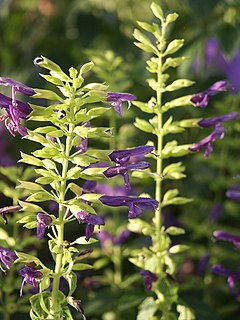
Salvia mexicana is a herbaceous shrubby perennial native to a wide area of central Mexico, growing at elevations from 2,600 to 8,500 feet. It grows in tropical areas in the south and arid subtropical habitats in the north, often at the edges of forests.
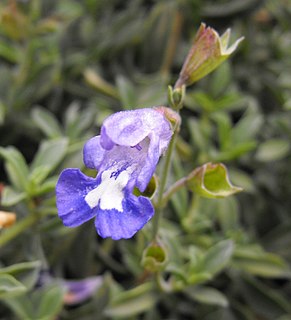
Salvia muirii is an evergreen perennial shrub native to limited areas east of the Cape of Good Hope and Mossel Bay on the southern coast of South Africa. It grows in an area influenced by the climate of the Indian Ocean, on rolling hills between 200 and 1000 feet elevation. The plant was first collected by Dr. John Muir, a Scottish physician and plant collector who spent many years in South Africa. Muir wrote to the botanist Harriet Margaret Louisa Bolus, who named the plant after him.
Salvia namaensis is an evergreen perennial shrub native to a limited area in Namibia and a wide area of South Africa. It is typically found growing on rocky slopes, shales, limestone hills, and sandy soils at 1,000 to 5,000 feet elevation. The specific epithet namaensis probably refers to the Nama tribe which is indigenous to Namaqualand, the region in Namibia where the plant grows.

Salvia polystachya is a herbaceous perennial native to central Mexico and south into Guatemala and Panama, typically growing at elevations from 5,000 to 10,000 feet in mild climates where there is some summer rain. It is rarely seen in horticulture.
Salvia repens is a herbaceous perennial native to South Africa and Lesotho, growing at elevations between 1,500 and 8,000 feet in open country and amongst shrubs. It has also adapted to grassland, grassy slopes, and shale banks. It was described and named by botanist George Bentham in 1833, based on a description by William John Burchell, with repens referring to the creeping rootstock.

Salvia scabra is a herbaceous perennial native to the southeastern strand of the Cape of Good Hope in South Africa, growing on sandy shores, coastal brush, and hilly slopes up to an elevation of 600 feet. It was described and named by Carl Thunberg in 1800. The leaves and an extract from the roots have been used medicinally in its native region for at least one hundred years. Salvia scabra was introduced to California gardens around 1996, and is extremely adaptable to many types of conditions. Since then it has spread to gardens in England, France, and Italy.
Salvia stenophylla is a perennial shrub native to a wide area of Southern Africa: South Africa, Botswana and Namibia. It grows on grassy or stony slopes, and in open countryside or among shrubs. It has been used traditionally as a disinfectant by burning it in huts after sickness, and it is also mixed with tobacco for smoking. Its specific epithet, stenophylla, refers to the narrow leaves.
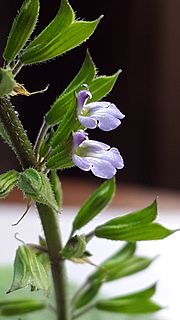
Salvia tiliifolia is a vigorous, herbaceous annual in the family Lamiaceae that is native to Central America. As a pioneer of abused areas, the plant has spread in modern times into: South America, as far south as Peru and Bolivia; the southwestern regions of the United States, including the states Texas and Arizona; Africa, including South Africa and Ethiopia; China, including the provinces of Yunnan and Sichuan.
Salvia thermarum is a perennial native to South Africa, discovered in 1998 by Ernst van Jaarsveld of Cape Town's Kirstenbosch National Botanical Garden. The common name is based on the location of the plant's discovery, near Goudini Spa, approximately 120 km from Cape Town—the specific epithet, thermarum, refers to the thermal baths where it was found. It is only found native in the Cape Provinces.
Salvia radula is a herbaceous perennial native to the northern provinces of South Africa, growing at elevations from 1,300 to 1,900 m. The plant grows to 0.3 to 0.75 m tall. Leaves are wooly and white underneath. It is closely related to Salvia disermas.











